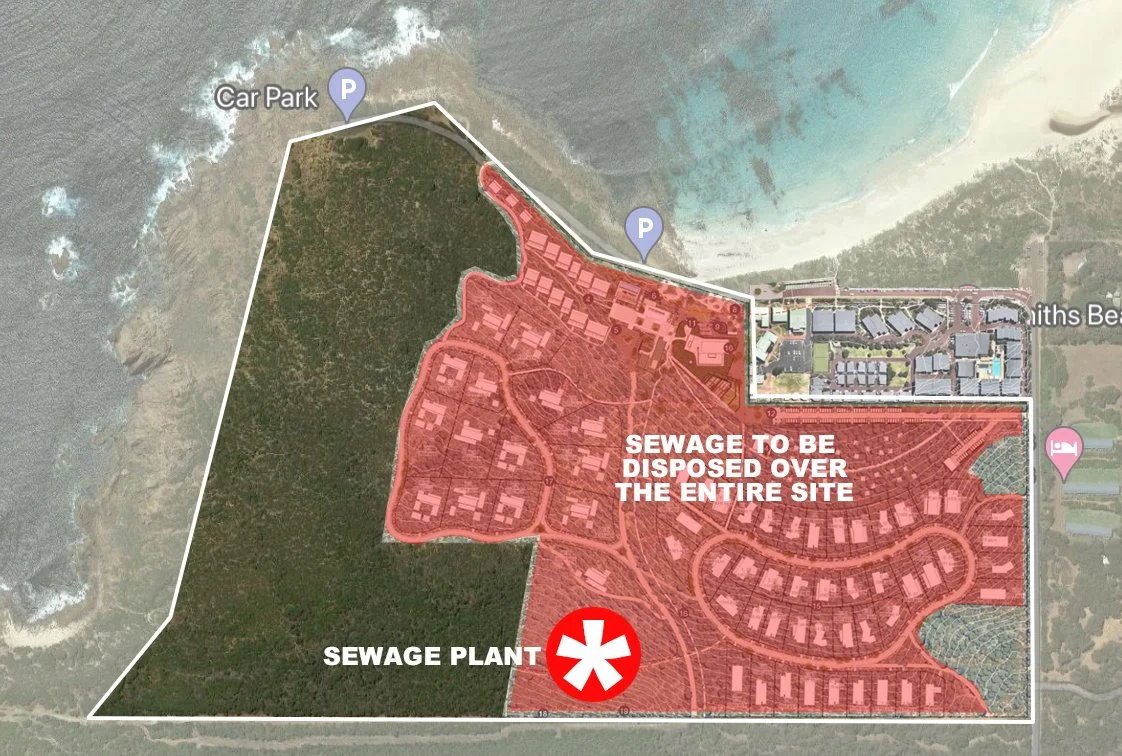Treating sewage onsite at Smiths Beach is an execrable idea
If you ever wanted an indication of how the developers at Smiths Beach are putting profits ahead of nature (and everything else!), look no further than how they propose to treat sewage.
Local planning rules require that the proposed development should have reticulated sewerage, which would connect to the existing system at Anniebrook near Dunsborough. Previous assessments of the proposed development site at Smiths Beach have concluded that this is practically and economically feasible.
Water Corp has also warned that onsite disposal is “unstainable in the long term” and that there is “not sufficient land area for treated wastewater reuse/disposal.”
Yet the developers are persisting with plans to both treat sewage and dispose of effluent onsite.
Not connecting sewerage to the mains will save the developers millions and increase their profits. But it will have crappy outcomes for the Smiths Beach community, it will risk the ecologically sensitive environment and impact the health of the beach we all love.
This includes:
Clearing of additional natural habitat to install underground infrastructure and piping to support on-site treatment and disposal of waste
Potential impacts from effluent discharge to the critically endangered Cape Leeuwin Freshwater Snail and the Augusts Microbial or Tufa (a unique type of fauna that was once widespread along the capes).
Decline in native plant health (and ultimately, death) due to nutrient levels in treated effluent being higher than they can tolerate.
Growth of weeds and non-native species that are not currently present in the area, and which would be stimulated by the high-nutrient discharge
Possible algae blooms because of high levels of nitrogen and phosphorus in the treated effluent.
DETAILS KEPT FROM OUR COMMUNITY
Despite more than four years of development work on the Smiths Beach project, a full working and proven design for the sewerage system is still not available.
In keeping with a proposal that has kept so many details hidden from the community, “Additional site perched water modelling and geotechnical investigations for winter permeability are [still] being developed to further support and refine the design as a part of the detailed design process.”
The risk to groundwater from the treated effluent and how the developer would mitigate this are also not known - again because the proposal that is currently being considered by the State Development Assessment Unit (SDAU) lacks sufficient detail and appropriate studies/data to make a proper judgement.
It’s alarming enough that the SDAU can ignore long-established planning laws in deciding whether projects like Smiths Beach can go ahead. But it’s even more concerning that this arm of the WA Planning Commission is prepared to assess proposals that are missing vital information that will permanently impact the environment.
Sewage treatment is just one of the issues the Smiths Beach Action Group and our community supporters have raised in more than 5600 submissions to the EPA review of the development proposal.
Our group does not oppose all development at Smiths Beach. However, we do expect developers to abide by planning rules, provide the details necessary for their proposal to be properly assessed and don’t choose project options that would leave our community and much-loved beach up Excrement Creek.
Surely that’s only fair?
Please tell your friends and your family (and anyone else you think might be interested) about the need to Save Smiths Beach.
Please also let the Environment Minister Matt Swinbourn, the Planning Minister John Carey and the Premier Roger Cook know what you think about the proposal for on-site sewage treatment at Smiths Beach.
The Premier can be contacted by email at wa-government@dpc.wa.gov.au and by phone on (08) 6552 5000.
Our community has rallied once before to stop large-scale, unsustainable development at Smiths Beach and with a collaborative and cohesive effort we can do it again.


